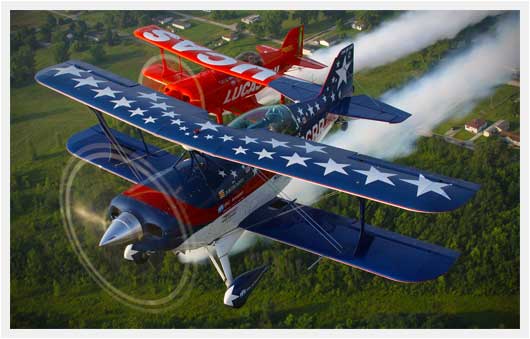Crazy Werth Brothers And The Inverted Tail Touch (Video)
 Thursday, September 1, 2011 at 10:22PM
Thursday, September 1, 2011 at 10:22PM My first thought is: don't try this at home... and my second thought is: man, that was beautifully executed! That's Billy Werth from Grayout Aerosports (Indianapolis) in the Pitts S2C and his brother David Werth doing the tail touch from the motorcycle. If you didn't know, Billy has been performing as the opposing solo in the Red Eagles performances at airshows this summer. He definitely knows what he's doing! And David has spent a lot of time on a motorcycle at high speed and close to a flying airplane. I'm guessing this trick is at least 12 and a half times harder than it appears!
If things go well, before too long I'll have my very own pilot report and video from spending some time upside down in N126BB with Billy... but I don't think we'll be flying quite that low!
 Billy Werth in a Red Eagles promo pic (from the Red Eagles facebook page)
Billy Werth in a Red Eagles promo pic (from the Red Eagles facebook page)
 Martt |
Martt |  5 Comments |
5 Comments | 













































































Reader Comments (5)
With tricks like this, I can just imagine another memorial on your home page.
Peter- I think understand where you comment comes from, but I’d like to disagree with you for a wide variety of reasons. I’ve got a rather lengthy response, both for your information and for the benefit of anyone with similar thoughts to yours. I’m not really meaning to be argumentative, but I wouldn’t have posted this video if I didn’t feel strongly about why I felt it was ‘safe’.
* First, to indirectly suggest that Amanda Younkin Franklin’s death was the result of an ill advised ‘trick’ completely misses the reality of that very unfortunate occurrence. Amanda’s severe burns and injuries were a result of a forced landing, the subsequent fire, and the inability to be freed immediately from the wreckage due to being attached to the airplane via a safety cable connected to her ankle. The forced landing was a result of a complete and immediate loss of engine power (I’ll address this possibility related to the Billy Werth video later) - a complete and immediate engine failure is extremely rare, and it also came at a very critical time in the routine. The airplane being flown by Kyle Franklin (Amanda’s husband) was at a relatively low altitude and didn’t have a lot of excess airspeed. Had the failure occurred during one of Kyle’s solo performances (without Amanda wing walking) or even at a time when Amanda was positioned between the wings, it simply would have been a very uneventful forced landing, most likely right on the runway. However, with Amanda strapped in on the top of the wing, it was essential that she move to a place of safety for the forced landing. Any landing conducted with a wing walker (or a wing rider) strapped to the top of the wing is dangerous due to the risk of the airplane flipping over as a result of a brake or other landing gear failure. The risk of this happening in a forced landing was far greater - thus it was a necessity that she get off the wing and into the cockpit. Kyle had very little altitude and airspeed to trade for time, and while Amanda did get into the cockpit, it appears that giving her enough time to do so meant that the airplane was getting very slow. The forced landing that followed was severe enough to cause another unusual occurrence: the smoke oil tank (probably mounted not far from the front cockpit) burst and the oil caught fire. Traditionally, I don’t believe there has been much concern for the dangers that this would cause, however, as a result of this unusual accident, it is indeed now considers a safety point to deal with. Lastly, the cable attached to Amanda’s ankle went from being a device of wing walking safety to an extreme problem, trapping her in the fire. Obviously, low level aerobatics and wing walking have an inherent level of risk that come with them, but those risks are managed as best as possible (and with great professionalism and care by Kyle and Amanda)… this situation as it took place had a highly unusual string of occurrences that unfortunately led to the tragic result of Amanda’s death. My point being that great planning, preparation, and risk management can’t always end safely, but there’s no reason to believe that Kyle and Amanda were doing anything other than performing at the highest levels of safety.
* Concerning the video above of Billy Werth and his brother David Werth: I have a list of items that I feel are directly important to understanding why this ‘trick’ (as performed) isn’t as dangerous as it might appear. Having said that, I will clearly acknowledge that the element performed in the video IS extremely difficult, dangerous, and should only ever be attempted by people who have EXTREME skill and have effectively managed the all risks at hand to the best of human ability.
* Billy has years of experience flying this exact aircraft as an aerobatic instructor and in low level airshows across the country. He also has a lot of experience with extreme and inverted low level flying. I know enough about Billy personally to know that he’s VERY safety conscious and very skilled at this exact kind of demonstration. I wouldn’t have posted this video if I didn’t know this about Billy. That’s also why my first point in the post is: don’t try this at home… very few people on earth should attempt what is done in this video.
* David has a massive amount of extreme motorcycle experience. I honestly don’t know how much, but I do know he’s not just a guy who likes to ride motorcycles down runways.
* Notice the amount of runway available for this procedure: it’s a really long runway and all of the maneuver is completed with a huge amount of available runway left. This adds a significant amount of safety to the effort.
* But what if the engine quit completely and immediately? You can be sure that Billy is carrying extra speed for this very reason. That’s another reason why it’s important to have a very experienced rider on the motorcycle so that high speeds can be carried out safely. If the engine quit completely and suddenly, all Billy would have to do is push forward on the stick trading the extra airspeed for a little altitude, roll right side up and land on the very long runway ahead of him. My guess is that there are only two critical goals for Billy when at the lowest altitude: maintain the desired altitude... and listen closely for any signs from the engine that it isn’t operating exactly as you expect it to.
* Notice the weather conditions. It appears to be a perfect day without winds that would greatly complicate the maneuver. This can be confirmed by watching the elevator on the Pitts as the motorcycle approaches. I don’t see any movement in the elevator at all (tho I’m guessing there is at least a little). This would indicate that winds are certainly not a factor in keeping the aircraft a safe distance from the ground or motorcycle… and it would also indicate that Billy is both in complete control and very comfortable in this position.
* Billy and David are brothers. You shouldn’t underestimate the importance of the connection between two people who have spent so much of their lives together. This factor alone adds a massive layer of safety in the event that system failures or other complications arise.
* The bottom line? It’s a difficult and dangerous maneuver, but it’s being performed with great caution, in conditions that clearly reduce the risks, and by people who have extensive training and experience for such things. Could it end badly? Of course it could. But to put it into perspective, the second leading cause of accidental death in North America (behind automobile accidents) is slipping and falling in the bathroom. Life is dangerous… it’s really all about how we go about managing the risks.
Here's YouTube from shot from inside.
http://www.youtube.com/watch?feature=player_embedded&v=IPSmA5Eax_w
I'll add one more thing to Martt's analysis. Notice how long the Pitts is down low before the motorcycle approaches . This give the bike a chance to make a smooth, controlled approach much like any formation flight is done. It also give them both a fair amount of time to knock it off is something isn't right. It looks completely crazy, but I can think of a lot of other things I have seen done at airshows that were MUCH more risky.
TenDegreesFalp- I should post that here too -
Race5- good point, and I definitely agree about seeing much more risky stuff than this at most airshows.